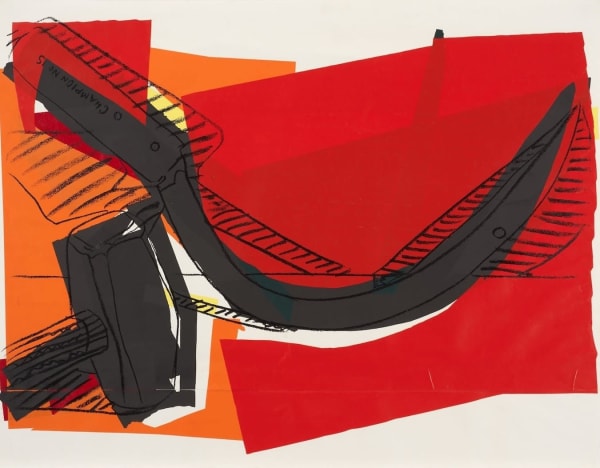
Andy Warhol
Each signed and numbered in pencil on lower left.
81.3 x 101.6 cm
Andy Warhol’s Hammer and Sickle portfolio was born out of a 1976 trip to Italy, where he was struck by the widespread graffiti featuring the hammer and sickle—the emblem of communist ideology representing the unity of industrial and agricultural laborers. Fascinated by the repetition and boldness of the symbol rather than its political meaning, Warhol saw artistic potential in its visual language. Upon returning to the United States, he asked his assistant, Ronnie Cutrone, to source reference materials for the project. Unable to find compelling images in political propaganda or flag designs, Cutrone instead purchased a real hammer and sickle, photographing them in various positions. These photographs became the basis for Warhol’s compositions.
In most of the prints, Warhol employed vivid red tones—a direct allusion to the communist flag and its charged associations. The color choice intensified the iconography, reinforcing the symbol’s power while also stripping it of its context, in line with Warhol’s Pop Art practice. His focus wasn’t to make a political statement in the traditional sense; rather, Warhol was intrigued by the symbolic weight the hammer and sickle carried during the height of Cold War tensions and how that could be reinterpreted through a modern, commercial lens.
Warhol’s decision to create a series centered on the hammer and sickle, rather than more familiar American symbols like the flag, was a deliberate artistic choice. It allowed him to reflect on the global discord of the time, particularly the ideological clash between capitalism and communism, without offering a direct critique. Through this series, he elevated a political symbol to the realm of pop culture iconography, treating it with the same detached irony he applied to celebrities and consumer goods.
The Hammer and Sickle portfolio, which includes screenprints FS II.161–164, stands as a striking example of Warhol’s ability to deconstruct symbols of authority and transform them into art objects. His treatment of the hammer and sickle—rendered with bold colors, exaggerated outlines, and overlapping forms—brings a sense of playfulness to an otherwise serious and provocative motif.
Within Warhol’s broader body of work, Hammer and Sickle represents a unique moment of political engagement. While much of his art focused on commercialism and fame, this series reveals his awareness of the global political landscape and his desire to explore how imagery can be repurposed and recontextualized. By juxtaposing the severity of communist symbolism with the flat, stylized language of Pop Art, Warhol blurs the line between propaganda and art, turning a symbol of fear and power into something strangely aesthetic, ironic, and even absurd.
For more information on Warhol’s Hammer & Sickle complete portfolio or to buy the complete Hammer & Sickle set, contact our galleries using the form below.
Join our mailing list
* denotes required fields
We will process the personal data you have supplied in accordance with our privacy policy (available on request). You can unsubscribe or change your preferences at any time by clicking the link in our emails.
521 W 26th Street
5th Floor
New York, NY 10001
Monday - Friday 10am - 5pm
Open Saturday by appointment only
info@guyhepner.com
+1 (212) 226 8680
177 10th Avenue
Ground Floor
New York, NY 10001
Tuesday - Friday 10am - 5pm
Saturday 11am - 5pm
info@guyhepner.com
+1 (212) 500 8190
This website uses cookies
This site uses cookies to help make it more useful to you. Find out more about cookies.



